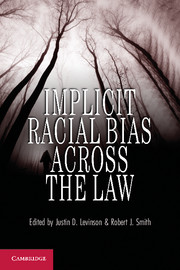Book contents
- Frontmatter
- Contents
- Contributors
- Acknowledgments
- Implicit Racial Bias Across the Law
- Introduction Racial Disparities, Social Science, and the Legal System
- 1 Implicit Racial Bias
- 2 Property Law
- 3 Criminal Law
- 4 Torts
- 5 Employment Law
- 6 Health Law
- 7 Education Law
- 8 Communications Law
- 9 Corporations Law
- 10 Tax Law
- 11 Intellectual Property
- 12 Environmental Law
- 13 Federal Indian Law
- 14 Capital Punishment
- 15 Reparations Law
- Index
- References
12 - Environmental Law
A Tale of Two Neighborhoods: Implicit Bias and Environmental Decision-Making
Published online by Cambridge University Press: 05 June 2012
- Frontmatter
- Contents
- Contributors
- Acknowledgments
- Implicit Racial Bias Across the Law
- Introduction Racial Disparities, Social Science, and the Legal System
- 1 Implicit Racial Bias
- 2 Property Law
- 3 Criminal Law
- 4 Torts
- 5 Employment Law
- 6 Health Law
- 7 Education Law
- 8 Communications Law
- 9 Corporations Law
- 10 Tax Law
- 11 Intellectual Property
- 12 Environmental Law
- 13 Federal Indian Law
- 14 Capital Punishment
- 15 Reparations Law
- Index
- References
Summary
Prologue: An Environmental Justice Story
For many people, Southampton, located on the Atlantic coast of Long Island, conjures up images of white, sandy beaches, quaint villages, and affluent summer visitors. East New York, Brooklyn, known during the 1980s and 1990s as the murder capital of New York City, elicits very different images: gangs, street violence, urban blight. Thomas Polsinelli, owner of Atlas Bio-Energy Corporation, owned a tract of land in each.
The two-acre tract in Southampton was fairly remote and adjacent to a railroad trestle; no homes or apartments or shops were located within a mile radius. The East New York tract was smaller, a half-acre, and, although zoned industrial, was located in a densely populated neighborhood. Atlas sought to benefit from the government's interest in (and funding for) alternative energy sources and developed a plan to construct a waste-wood to energy incinerator. The corporation initially concluded that the Southampton site was the better location for the waste-wood incinerator and submitted a proposal simultaneously to the state government energy fund for a start-up grant and to Southampton's town council. The state energy fund was very enthusiastic and approved Atlas for a grant. Atlas also negotiated a $6 million agreement to sell the energy. The township's reaction was quite different. The proposal was advertised in the local newspaper, and more than 200 residents showed up to protest the plan. Atlas quickly withdrew the proposal and decided to build the incinerator on its other property.
- Type
- Chapter
- Information
- Implicit Racial Bias across the Law , pp. 192 - 208Publisher: Cambridge University PressPrint publication year: 2012



